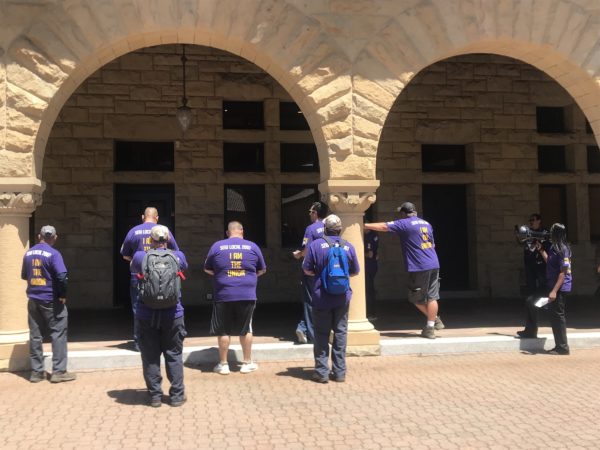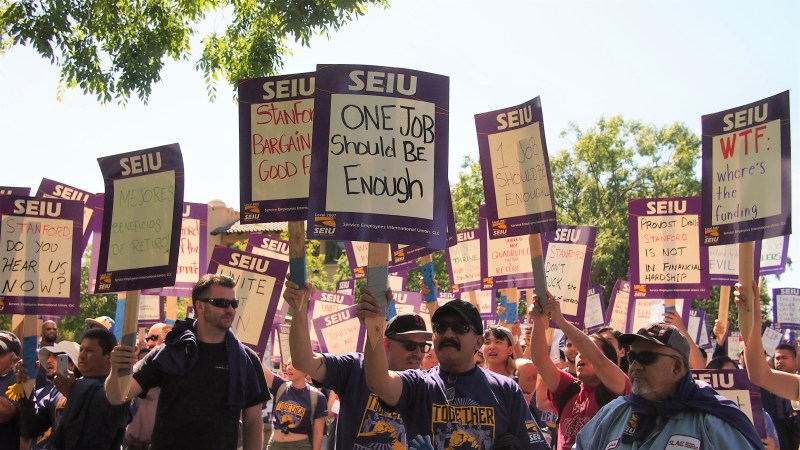Update: The tentative agreement was approved in a ratification vote by SEIU Local 2007 union members on Friday.
After negotiations dating back to May, Stanford announced on Saturday that it has formed a tentative agreement with the Service Employees International Union Higher Education Workers Local 2007 (SEIU) on a new five-year contract for the roughly 1,270 SEIU-represented workers at the University. But multiple union members have already left comments of disapproval on the SEIU Facebook post about the agreement.
The new contract, which is subject to a ratification vote by SEIU members on Friday, would replace a previous contract between the union and the University that was enacted in 2014 and ended on Saturday. SEIU has received an outpouring of student support during the negotiations, ranging from Facebook profile pictures and email blasts to an op-ed in The Daily.
Among the changes outlined in the potential contract are a series of wage increases totaling 18% over the contract’s five-year span, as well as separate pay adjustments for food service workers, custodians and custodian leaders hired after 1997, in order to reduce the wage gap between these groups.
Other elements of the tentative agreement, as listed by SEIU, include free feminine-hygiene products in all women’s and gender neutral bathrooms, as well as new non-discrimination language and a vacation cancellation policy.
The brackets of eligibility for the Medical Contribution Assistance Program (MCAP), which pays for the lowest-cost medical insurance plan when workers covers their spouse and/or children on a University-sponsored plan, have also been broadened to make more workers eligible for subsidies. Workers on the Staff Retirement Annuity Plan (SRAP) on or after Sunday will have their retirement income rate through the program increased.
Despite these improvements, workers would like to see other changes that are not addressed in the tentative agreement.
Changes to retiree health care, for instance, have not been included in the tentative agreement, though an SEIU announcement about the agreement states that the union will be meeting with the chair of the Affordability Task Force, vice president for Business Affairs, associate vice president of Benefits and associate vice president of Employee Labor Relations regarding potential “solutions to the affordability issues surrounding retiree health care.”
Another area yet to be resolved is University policy on lactation breaks and room accessibility. SEIU wrote that it and Stanford are “committed to addressing the specific issues that bargaining unit members have with the current policies,” and that a meeting will take place between relevant parties in the future.
University workers have criticized the tentative agreement in comments on SEIU’s Facebook post on the subject. Stanford project crew worker Jose luis Hermosillo wrote, “Hell no,” and maintenance mechanic Daniel Schelstraete wrote, “Nice try” on a photo of “highlights” from the agreement included in the post.
“This is BS,” wrote animal care assistant Marcelo Torres in another comment.
Torres wrote that he was expecting 7% wage increases annually for three years, referring to an earlier union demand, whereas Hermosillo called out what he sees as a lack of sufficient progress in health care and retirement, among other non-wage aspects of the agreement. Maintenance mechanic Valentino Puntanilla wrote, “my vote is no,” adding that he sees the plan as “too long and too little.”
The tentative agreement comes after months of criticism directed toward Stanford by the union in “Bargaining Updates” posted on the union’s website. The union expressed frustration with what it saw as University ignorance of SEIU proposals made earlier in the negotiations process.
“No proposal made by the Union has been ignored,” wrote Stanford spokesperson E.J. Miranda in an email to The Daily. “In fact, much time has been spent in negotiations to ensure we understand the Union’s underlying interests prompting each proposal.”
Stanford had reached tentative agreements with SEIU “on various topics” prior to announcement of the tentative agreement on Saturday, according to Miranda.
Workers and their supporters have for years expressed frustration specifically with wages insufficient for affording housing in the Bay Area, leading to multi-hour commutes.
Union member Michael Moore, who has worked at the University for 16 years and currently transports food around campus, told The Daily that he moved from nearby Menlo Park to Tracey, about 60 miles from Stanford’s campus, in order to find affordable housing. The result is about two extra hours spent driving each work day.
“We’re looking for a better quality of life,” Moore said. “We can’t make it here on the wages that we’re getting. We can’t make it.”
He believes that, over the time he has worked at the University, conditions have gotten worse for workers due to cost-of-living increases in the area. Fellow SEIU member Jane Shtalenkova, who works at the SLAC National Particle Accelerator, agrees.
“It’s really critical that they [Stanford’s leaders] don’t consider us an enemy in this [contract] situation,” Shtalenkova said. “We’re simply giving them the reality of our situation that they cannot see from a purely numbers’ perspective at this point in time.”

Moore and Shtalenkova both took part in an SEIU march to the President’s Office on Aug. 7. The union members distributed a petition calling on President Marc Tessier-Lavigne and Provost Persis Drell to “commit the University’s bargaining team to support meaningful changes that address the affordability challenges” of campus workers.
“What we’re actually doing is we’re sounding the alarm about things that Stanford’s financial analysis isn’t going to show them for another four years, not until everybody’s gone,” Shtalenkova said at the time.
“The university has a deep respect and appreciation for our staff employees, including those represented by SEIU,” Miranda wrote. “They perform vital work for our university community in many important areas, and everyone in the university benefits from their dedication and commitment to high-quality work.”
Contact Holden Foreman at hs4man21 ‘at’ stanford.edu.
